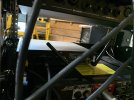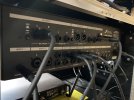No, you need to set your gain and effects relative to your wireless. Think of it this way…if you introduced a new guitar to your rig with say, either super low or super high output pickups, you would have to completely adjust your gain settings relative to those pickups to get the tone you wanted, right? Every guitar is different so usually you begin crafting tonality based upon the way the guitar hits the signal chain, sometimes that means your effects first, sometimes it means the front end of your amp first. You’ve already done this with your guitar(s), while plugged in via cable. You’re introducing a completely foreign gain structure to your ecosystem now by using a wireless system. (Quick background, I spent nearly 20 years working at a large guitar shop, have played in multiple live bands, and now design and install PA systems full-time. I don't say that for gloating...just letting you know I have some experience).
The Sennheiser G4 series has adjustable gain stages on both the transmitter, and the receiver. This is to compensate for differing incoming signal levels hitting the receiver, as well as compensation for gain staging once leaving the receiver. Sennheiser doesn't know if you're using a guitar into the transmitter, a headset microphone, a lapel microphone, a wind microphone, etc. So they allow you a sensitivity control to adjust the gain staging as necessary, to have proper incoming signal. As I mentioned in my previous post, the first thing you should be doing is playing a mixture of your guitars, and finding the sweet spot on the transmitter by adjust the sensitivity setting (on the transmitter) while playing the guitars and watching the front of the receiver. You'll see the "AF" level on the receiver, next to the "RF" level. You should be adjusting the sensitivity to where your signal level averages close to "0" on the meter, without peaking, while playing at average intensity on your guitar. This should be a VISUAL adjustment, not an audible one. Your ears will deceive you. Do this without having your amp/AxeFX turned on or audible. Adjust the sensitivity between the mixture of guitars so that you're close to "0". It's unlikely that this will be a perfect scenario because as you said you have a mixture of guitars and pickups. There is ALWAYS a compromise when using wireless.
Once you've gone through and found the sweet spot of sensitivity setting on the transmitter, you should then start adjusting the AF Out setting on the receiver. (This is what will compensate for when you mentioned after adjusting things the result was virtually no gain/etc. This stage is essentially output gain compensation). The easiest way to do this, is to bounce back and forth between your wireless, and a cable, hitting the front of your signal chain going into your amp (where your output cable from your wireless would plug in). Going back and forth here will give you an audible example of the difference between these two worlds as far as input gain goes. For example, say you hit the beginning of your signal chain and it sounds "right", and then you switch to the wireless, and all of a sudden you have little to no gain, or way more gain than when the cable was plugged in directly. You then use the AF Out setting to adjust and compensate for the difference on the wireless receiver. If when using the wireless you have way more gain than when a cable is plugged in (sans wireless), you would dial back the AF Out. If the opposite and you have little to no gain as compared to a direct cable, you would adjust the AF Out setting on the receiver to hit the front of the signal chain harder. You do this back and forth until you have a close relationship between tonalities and gain staging between the wired and wireless options. Once you have found the AF Out setting that is suitable, you then have to shape your Amp/AxeFX/etc settings around the wireless system. You can't ever set up a rig with a wired cable, have it sounding how you like, go to a gig, plug a wireless system in, and expect it to sound identical. You have to shape your tonality based on the way you're plugging into it. A lot of times after adjust the gain staging on the transmitter and receiver, you can get to where it's a usable balance and not need much if any adjustment on the amp/Axe between the two, but it may never be perfect. Another setting to consider in the transmitter is the Cable Emulation.
Again, wireless is always a compromise. You cut the cable, and now you're dealing with companders and other settings that will affect your tonality. You have to shape your sound around it. Adjust incoming gain, and output gain. Find the sweet spot.






